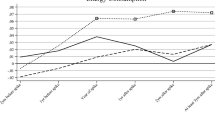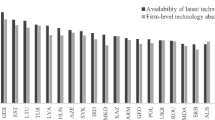Abstract
Dutch greenhouse horticulture firms are energy-intensive and major emitters of greenhouse gases. This paper develops a theoretically consistent model that is able to describe the greenhouse firms’ behaviour regarding energy use and investments in energy technology. The behaviour of the firm is modelled using a combination of a dynamic cost function and a static profit function framework. The optimal quantity of energy is derived from the link between these two functions. The model is applied to a panel of 97 Dutch greenhouse firms over the period 2001–2008. The results show that most Dutch greenhouse firms shift from being net electricity users to net electricity producers in the long term. Investing in energy capital contributes to reducing net energy use, however it increases the quantity of carbon dioxide emissions due to an increase in electricity production. A 1 % increase of the price of gas reduces carbon dioxide emissions by 1.6 %.
Similar content being viewed by others
Notes
The two simultaneous differential equations cannot easily be solved analytically; however, an approximation to the solution is taken to solve the problem. In our case, investment demand in the long-term (\(\dot{K}^{*})\) is approximated by \(\frac{dK^{*}}{dt}\).
Our panel data set includes 54.54 % observations with a positive investment, 44.79 % of observations with no (zero) investment and 0.67 % observations with a negative investment.
References
Agbola FW (2005) Optimal intertemporal investment in Australian agriculture: an empirical investigation. Agric Econ Rev 6:5–15
Asche F, Kumbhakar S, Tveteras R (2008) A dynamic profit function with adjustment costs for outputs. Empir Econ 35:379–393
Chambers RG (1988) Applied production analysis: a dual approach. Cambridge University Press, Cambridge
Energy Matters (2011) Ontwikkeling barometer marktpositie glastuinbouw WKK (in Dutch). Energy Matters
Epstein LG (1981) Duality theory and functional forms for dynamic factor demands. Rev Econ Stud 48:81–95
Epstein LG, Denny MGS (1983) The multivariate flexible accelerator model: its empirical restrictions and an application to U.S. manufacturing. Econometrica 51:647–674
Fernandez-Cornejo J, Gempesaw II CM, Elterich JG, Stefanou SE (1992) Dynamic measures of scope and scale economies: an application to German agriculture. Am J Agric Econ 74:329–342
Gardebroek C, Oude Lansink AGJM (2004) Farm-specific adjustment costs in Dutch pig farming. J Agric Econ 55:3–24
Howard WH, Shumway CR (1988) Dynamic adjustment in the U.S. dairy industry. Am J Agric Econ 70: 837–847
Ministerie van Landbouw Natuur en Voedselkwaliteit (2008) Convenant Schone en Zuinige Agrosectoren. The Hague
Oude Lansink A (2003) Technical efficiency and CO2 abatement policies in the Dutch glasshouse industry. Agric Econ 28:99–108
Oude Lansink A, Stefanou SE (1997) Asymmetric adjustment of dynamic factors at the firm level. Am J Agric Econ 79:1340–1351
Oude Lansink A, Van Der Vlist A (2008) Non-parametric modelling of CO2 emission quota. J Agric Econ 59:487–497
Pietola K, Oude Lansink A (2006) Energy-saving technology choices by Dutch glasshouse firms. J Agric Econ 57:129–144
Product Board Horticulture (2012) Glastuinbouw maakt nieuwe afspraak met overheid over lagere CO2-uitstoot
Serra T, Stefanou S (2010) A dynamic dual model under state-contingent production uncertainty. Eur Rev Agric Econ 37:293–312
Stefanou SE (1989) Returns to scale in the long run: the dynamic theory of cost. South Econ J 55:570–579
Stefanou SE, Fernadez-Cornejo J, Gempesaw II CM, Elterich JG (1992) Dynamic structure of production under a quota: the case of milk production in the Federal Republic of Germany. Eur Rev Agric Econ 19:283–299
Syed A (2011) Energy use reduction and input productivity growth in Australian industries. In: 55th conference Australian Agricultural and Resource Economics Society (AARES), Melbourne, VIC, Australia
Thijssen G (1996) Farmers’ investment behavior: an empirical assessment of two specifications of expectations. Am J Agr Econ 78:166–174
Vasavada U, Ball VE (1988) A dynamic adjustment model for U.S. agriculture: 1948–79. Agric Econ 2: 123–137
Vasavada U, Chambers RG (1986) Investment in U.S. Agric Am J Agric Econ 68:950–960
Weersink A (1990) Nonrobustness of dynamic dual models of the northeastern and U.S. dairy industries. Northeast J Agric Resour Econ 19:12–16
Acknowledgments
We gratefully acknowledge the Agricultural Economics Research Institute (LEI) for making the data available for this study and we would like to thank the anonymous referees for their valuable comments.
Author information
Authors and Affiliations
Corresponding author
Appendices
Appendix A
1.1 Estimation results
Parameter | Estimate | SE | Parameter | Estimate | SE |
|---|---|---|---|---|---|
\(a_{11}\) | 268.877 | 91.05** | \(g_{4}\) | 5.561 | 7.232 |
\(a_{12}\) | \(-\)25.891 | 101.6 | \(g_{5}\) | 0.01129 | 0.018 |
\(a_{22}\) | 96.732 | 308.6 | \(g_{6}\) | \(-\)880.968 | 1958.2 |
\(\beta _{1}\) | \(-\)211.088 | 46.44** | \(g_{11}\) | \(-\)1866.29 | 2448.4 |
\(\beta _{2}\) | 117.744 | 37.65** | \(g_{12}\) | 2891.196 | 2405.3 |
\(\beta _{3}\) | 0.276 | 0.079** | \(g_{13}\) | \(-\)14464.2 | 20014.1 |
\(\beta _{4}\) | 0.763 | 0.12** | \(g_{22}\) | \(-\)4633.74 | 2465.9* |
\(\beta _{11}\) | 16.465 | 13.299 | \(g_{23}\) | 17777.23 | 10471.9* |
\(\beta _{22}\) | \(-\)25.789 | 6.55** | \(g_{33}\) | \(-\)136522 | 429762 |
\(\beta _{33}\) | \(-\)0.00006 | 0.00003* | \(Q_{11}\) | 0.003126 | 0.00409 |
\(\beta _{44}\) | 0.00007 | 0.000019** | \(Q_{12}\) | \(-\)0.00006 | 0.000039 |
\(\beta _{55}\) | \(-\)7.238 | 4.72 | \(Q_{13}\) | 0.1694 | 0.2684 |
\(\beta _{12}\) | 13.829 | 6.45** | \(Q_{22}\) | \(4.129^{-6}\) | \(6.472^{-6}\) |
\(\beta _{13}\) | 0.0000158 | 0.018 | \(Q_{23}\) | 0.000713 | 0.00383 |
\(\beta _{14}\) | 0.004219 | 0.01 | \(Q_{33}\) | \(-\)30.7669 | 69.527 |
\(\beta _{15}\) | \(-\)19.625 | 6.06** | \(R_{11}\) | 21.7229 | 2.3388** |
\(\beta _{23}\) | \(-\)0.0299 | 0.013** | \(R_{12}\) | 7.408 | 2.1766** |
\(\beta _{24}\) | 0.0078 | 0.0036** | \(R_{13}\) | \(-\)4.0637 | 7.516 |
\(\beta _{25}\) | 2.438 | 2.98 | \(R_{21}\) | \(-\)0.09834 | 0.0319** |
\(\beta _{34}\) | \(2.01^{-6}\) | \(-9.68^{-6}\) | \(R_{22}\) | 0.11279 | 0.0349** |
\(\beta _{35}\) | \(-\)0.00398 | 0.01 | \(R_{31}\) | \(-\)52.947 | 248.9 |
\(\beta _{45}\) | 0.0117 | 0.010 | \(R_{32}\) | \(-\)115.443 | 270.3 |
\(\gamma _{11}\) | 296.03 | 25.95** | \(D_{1}\) | \(-\)195.057 | 63.307** |
\(\gamma _{12}\) | \(-\)69.609 | 20.272** | \(D_{2}\) | 238.703 | 64.27** |
\(\gamma _{13}\) | \(-\)0.0289 | 0.043 | \(R_{33}\) | \(-\)2.33484 | 55.17 |
\(\gamma _{14}\) | 0.226 | 0.087** | \(R_{23}\) | \(-\)0.288817 | 0.0603** |
\(\gamma _{21}\) | 60.9398 | 23.26** | \(\sigma \) | 269.77 | 128.3** |
\(\gamma _{22}\) | 139.87 | 17.955** | |||
\(\gamma _{23}\) | \(-\)0.023 | 0.038 | |||
\(\gamma _{24}\) | 0.269 | 0.1408* |
Appendix B
1.1 Elasticities for CO\(_{2}\)
Using both the direct and the indirect effects, one can derive the responses of CO\(_{2}\) emissions quantity to a change in an energy input price. In the short term, the CO\(_{2}\) emission elasticities show the effect of a price change before adjustments in energy capital or energy quantity have taken place. The short-term CO\(_{2}\) emission elasticity is:
The first term between the brackets corresponds to the direct effect to a change in price \(w_{m}\), and indicates the response of the quantity of gas to the change in price. The second term between the brackets is the indirect effect that corresponds to the response of gas quantity to a change in the price when the quasi-fixed input energy quantity is optimal in the short term.
In the long term, energy output and the quasi-fixed input energy capital could adjust to their optimal levels. Now the responses of the specific quantity to a gas price change when energy capital and the output energy quantity fully have adjusted to their long-term equilibrium level, are taken into account. In the long term, the responses of gas quantity to a change in optimal energy quantity or optimal energy capital are derived from Eqs. (25a) and (26). The long term CO\(_{2}\) emission elasticity is expressed as:
Rights and permissions
About this article
Cite this article
Verreth, D.M.I., Emvalomatis, G., Bunte, F. et al. Dynamic and Static Behaviour with Respect to Energy Use and Investment of Dutch Greenhouse Firms. Environ Resource Econ 61, 595–614 (2015). https://doi.org/10.1007/s10640-014-9808-6
Accepted:
Published:
Issue Date:
DOI: https://doi.org/10.1007/s10640-014-9808-6




